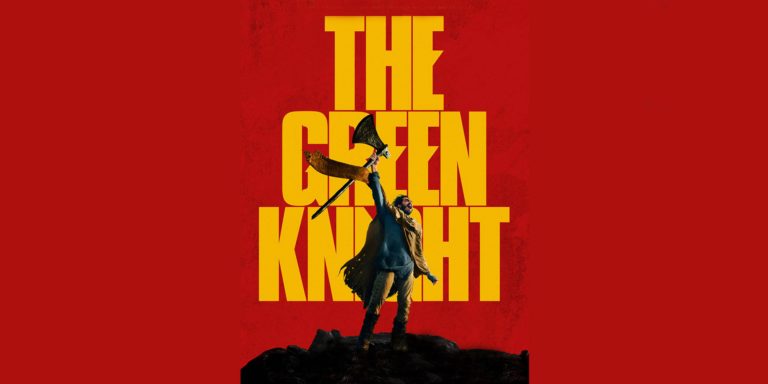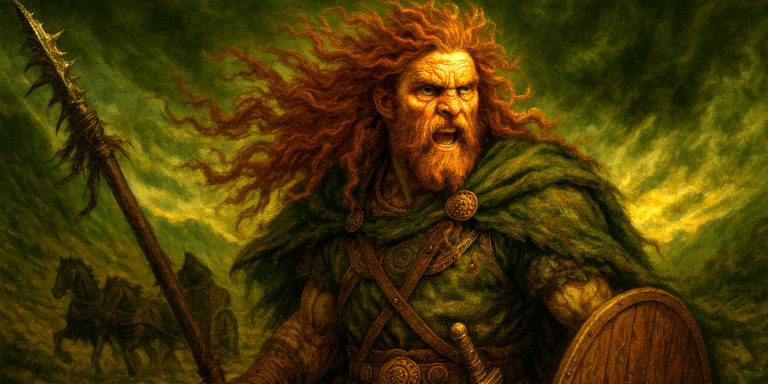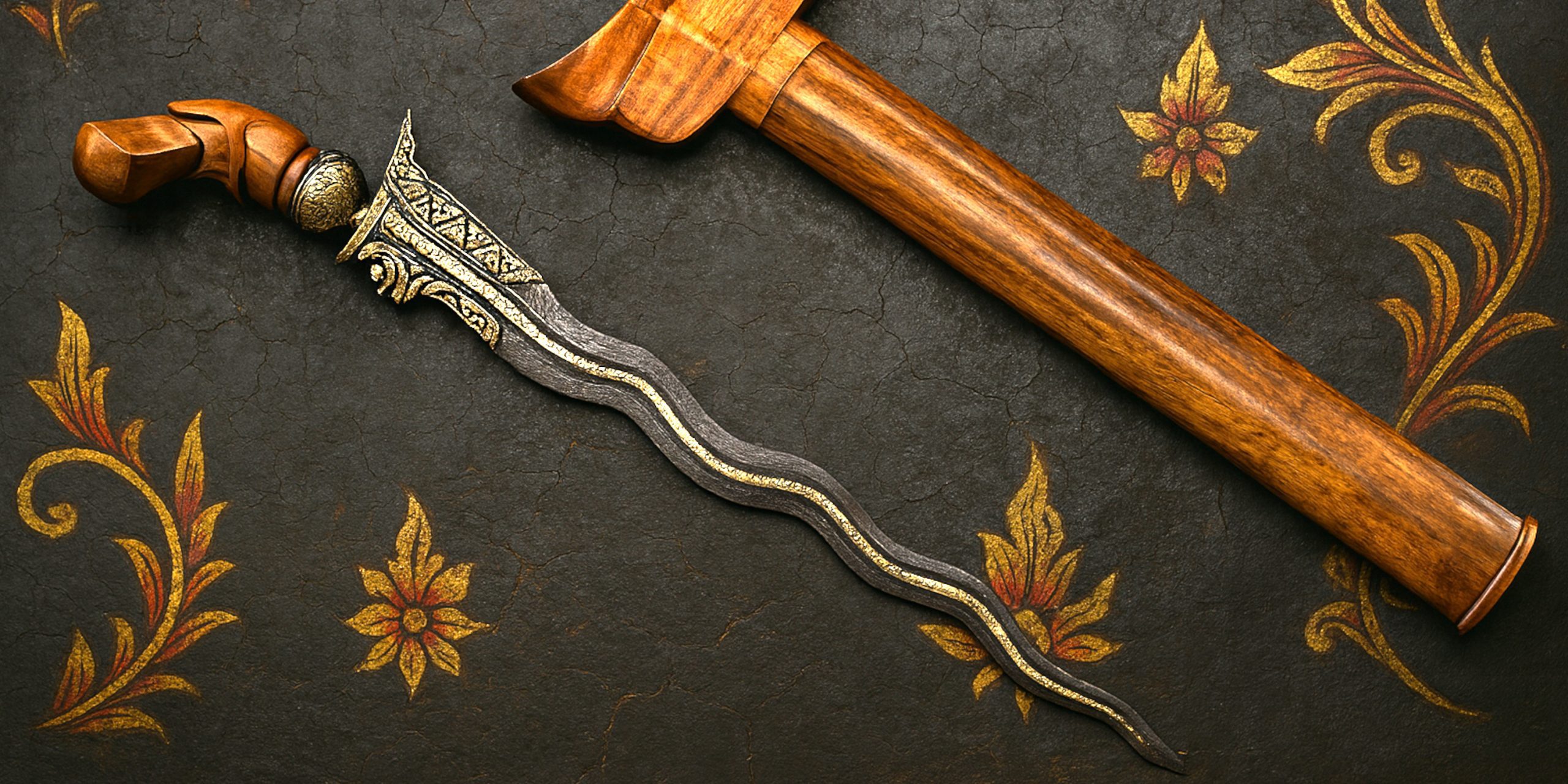
Asian swords form an enormous part of global martial heritage. Each region shaped blades around its own warfare, philosophy and available materials. The result is a range of sword types with distinct silhouettes, forging techniques and cultural weight. This guide focuses on the most influential forms across East, South and Southeast Asia, along with practical notes for museum viewing and collecting.
Major Iconic Sword Types of Asia
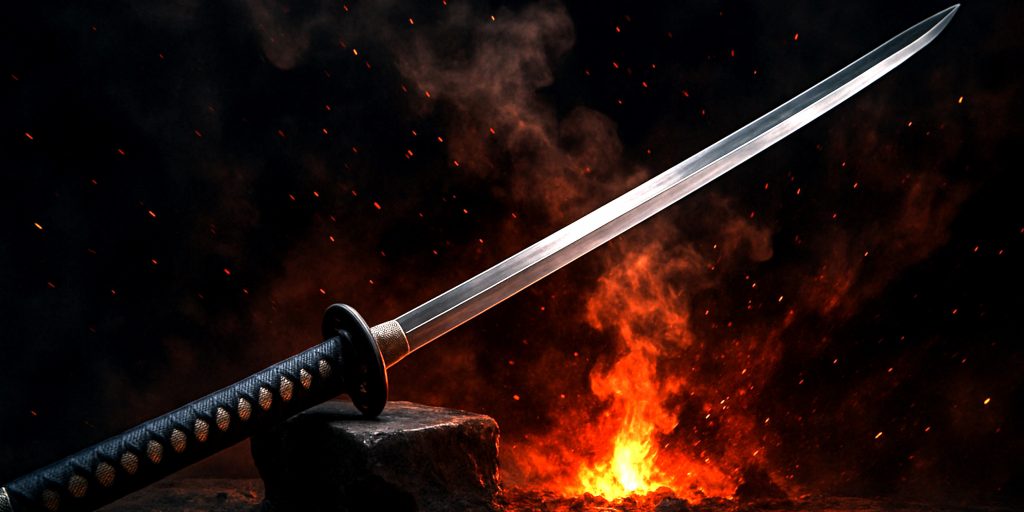
Japanese Katana
A curved, single edged sword associated with the samurai.
Key features
- Curved profile with moderate taper
- Exceptional differential hardening with visible hamon
- Paired traditionally with the wakizashi
Table, Katana Specifications
| Feature | Typical Detail |
|---|---|
| Length | 60 to 73 cm |
| Blade Type | Single edged, curved |
| Steel | Tamahagane folded steel |
| Primary Use | Slashing, duelling, battlefield command sidearm |
Legacy
The katana carries heavy symbolic meaning in Japan, linked to status, skill and personal honour. Its craftsmanship also set a technical benchmark for pattern, polish and refinement.
Where to see
- Tokyo National Museum
- Kyoto National Museum
- British Museum, London
- Metropolitan Museum of Art, New York
Collectors information
- Antique katana with signed tangs command high prices.
- Condition of the polish and the clarity of the hamon influence value.
- Expect premium prices for blades from renowned schools such as Bizen or Soshu.
Chinese Jian
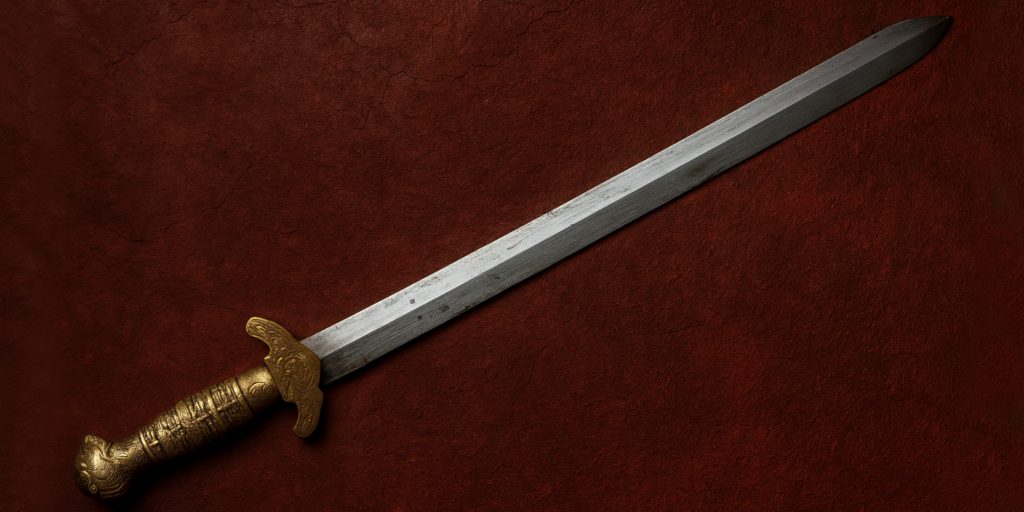
A straight, double edged sword known as the gentleman of weapons.
Key features
- Straight, balanced for both thrusting and cutting
- Often carried by scholars or officers
- Elegant fittings with traditional designs
Table, Jian Specifications
| Feature | Typical Detail |
|---|---|
| Length | 45 to 70 cm |
| Blade Type | Double edged |
| Steel | Pattern welded or high carbon steel |
| Primary Use | Civilian defence, officer weapon, martial practice |
Legacy
The jian symbolises refinement and is deeply tied to literature and Taoist philosophy. It influenced many later straight blades in Asia.
Where to see
- Shaanxi History Museum
- National Museum of China
- Asian Civilisations Museum, Singapore
Collectors information
- Earlier dynastic jian are rare.
- Provenance is crucial due to the number of modern replicas.
- Antique fittings and scabbards are highly desirable.
Chinese Dao

A curved, single edged sabre widely used by infantry and cavalry.
Key features
- Pronounced curve
- Strong chopping power
- Many sub types including willow leaf, oxtail and goose quill forms
Table, Dao Specifications
| Feature | Typical Detail |
|---|---|
| Length | 60 to 80 cm |
| Blade Type | Single edged, curved |
| Steel | Pattern welded or mono steel |
| Primary Use | Battlefield sabre, cavalry, infantry shock weapon |
Legacy
The dao became the dominant battlefield sword in China due to its versatility. It shaped military sabre development across East Asia.
Where to see
- Forbidden City Armoury Collections
- National Palace Museum, Taipei
- Royal Armouries, Leeds
Collectors information
- Oxtail dao from the late Qing period are the most common.
- Earlier Ming examples command significantly higher prices.
Korean Hwando
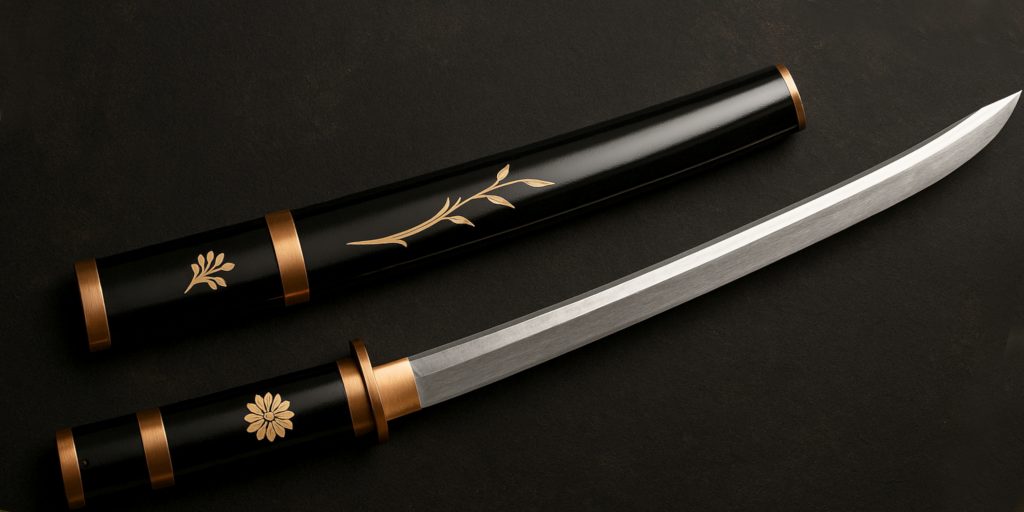
A single edged sword used by military officers during the Joseon period.
Key features
- Straight or slightly curved
- Often worn with formal dress
- Known for sturdy construction
Table, Hwando Specifications
| Feature | Typical Detail |
|---|---|
| Length | 60 to 70 cm |
| Blade Type | Single edged |
| Steel | High carbon steel |
| Primary Use | Officer sidearm, ceremonial use |
Legacy
The hwando represents the bureaucratic military culture of Joseon Korea. While practical, it also served as a status symbol.
Where to see
- National Museum of Korea, Seoul
- Gyeongbokgung Palace Collections
Collectors information
- Authentic Joseon blades with original scabbards are sought after.
- Decorative court pieces are often more valuable than battlefield examples.
Indian Talwar

A curved sabre widely used across Mughal and Rajput India.
Key features
- Strong curve with a disc pommel
- Often paired with ornate hilts and wootz steel blades
- Suited to powerful slicing cuts
Table, Talwar Specifications
| Feature | Typical Detail |
|---|---|
| Length | 70 to 90 cm |
| Blade Type | Curved, single edged |
| Steel | Wootz or patterned steel |
| Primary Use | Cavalry and infantry sabre |
Legacy
The talwar shaped much of South Asian sword culture and remains instantly recognisable through its pommel and sweeping line.
Where to see
- National Museum, New Delhi
- Victoria and Albert Museum, London
- Royal Armouries, Leeds
Collectors information
- Blades with visible wootz pattern command high prices.
- Rajput hilts are especially prized for their decoration.
Indian Khanda

A straight, broad bladed sword used extensively by Rajput and Sikh warriors.
Key features
- Straight, weighty blade
- Reinforced spine and basket style hilt
- Designed for decisive chopping strikes
Table, Khanda Specifications
| Feature | Typical Detail |
|---|---|
| Length | 80 to 100 cm |
| Blade Type | Straight, broad |
| Steel | High carbon steel or wootz |
| Primary Use | Close combat, heavy striking |
Legacy
The khanda is a symbol of martial strength in northern India and appears widely in Sikh iconography.
Where to see
- Patiala Armoury Collections
- Napar Museum, Rajasthan
Collectors information
- Early basket hilts with original decoration fetch premium prices.
- Many antique examples were reforged, so careful authentication is needed.
Filipino Kampilan

A long, distinctive blade associated with Mindanao and the Moro peoples.
Key features
- Wide profile that flares near the tip
- Long grip suited for two handed use
- Iconic carved hilt forms
Table, Kampilan Specifications
| Feature | Typical Detail |
|---|---|
| Length | 90 to 110 cm |
| Blade Type | Single edged, flared |
| Steel | Indigenous steel, often laminated |
| Primary Use | Warrior weapon, coastal defence, tribal warfare |
Legacy
The kampilan became known globally after its use against early European colonisers. It remains one of the most recognisable Filipino blade types.
Where to see
- National Museum of the Philippines
- Ayala Museum, Makati
Collectors information
- Antique kampilan with original rattan bindings are in demand.
- Provenance within specific Moro communities increases value.
Indonesian Kris
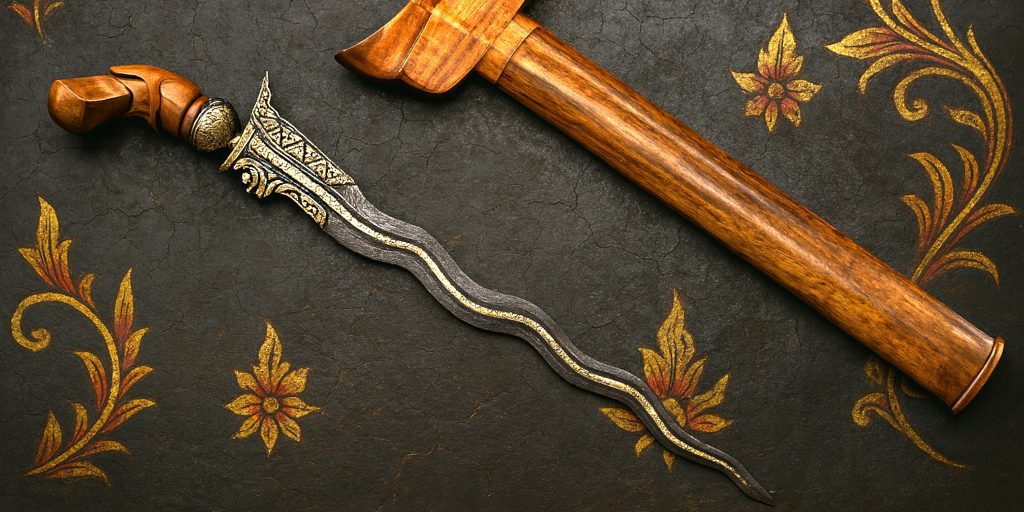
A wavy or straight bladed dagger with spiritual significance across Java, Sumatra and the wider region.
Key features
- Distinctive wavy blade shaped in pamor patterns
- Considered both a weapon and a spiritual object
- Handles often carved with regional symbolism
Table, Kris Specifications
| Feature | Typical Detail |
|---|---|
| Length | 30 to 50 cm |
| Blade Type | Wavy or straight |
| Steel | Pattern welded pamor |
| Primary Use | Ceremonial, personal weapon, status symbol |
Legacy
The kris is inseparable from Indonesian identity. It is recognised by UNESCO as cultural heritage.
Where to see
- Museum Nasional Indonesia
- Yogyakarta Palace Collections
Collectors information
- Authenticated pamor patterns are key to valuation.
- Age, hilt style and regional origin all affect price.
Summary Table, All Swords at a Glance
| Region | Sword Type | Form | Hallmark Features |
|---|---|---|---|
| Japan | Katana | Curved, single edged | Hamon, refined polish |
| China | Jian | Straight, double edged | Scholarly symbolism |
| China | Dao | Curved sabre | Infantry and cavalry mainstay |
| Korea | Hwando | Straight or slightly curved | Officer status sword |
| India | Talwar | Curved sabre | Wootz steel, disc pommel |
| India | Khanda | Straight, heavy | Broad blade, basket hilt |
| Philippines | Kampilan | Long, flared | Two handed, tribal weapon |
| Indonesia | Kris | Wavy or straight | Pamor pattern, spiritual role |
Final Notes for Collectors
- Authenticity and provenance are essential because replicas are widespread.
- Specialist dealers with regional expertise are recommended.
- Condition of the blade, scabbard and fittings determines most of the valuation.
- Export restrictions vary by country, especially for antique katana and kris.

